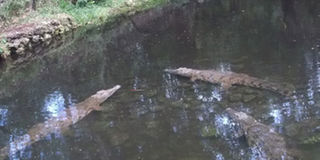Breaking News: At least 10 feared to have drowned in Makueni river
From a wasteland to paradise

Crocodiles at Haller park. PHOTO/RUPI/MANGAT
What you need to know:
- Rene Haller, the man who transformed the lifeless quarry into a thriving ecosystem, creaed a natural world that brought in species like the red legged millipede (Mombasa trains) to munch on the dry casuarina needles.
- The droppings of the millipede made it easier for bacteria to break down resulting in a rich layer of humus that allowed other plants to grow.
- The mangroves were then planted to filter the salt water and for the semi-aerial roots to offer a nursery for young fish and then in came the crocodiles that swim leisurely around the streams.
Having spent a hot morning at the iconic Fort Jesus in Mombasa and strolling through the new Butterfly House that showcases Kenya’s stunning variety of winged beauties, I take on Marlene Reid’s offer for the regular once-a-month Friends of Fort Jesus (FFJ) bird walk.
The walks are in late afternoon when birds begin to stir.
Beady eyes pop up from the rivulets running through the mangrove groves. I had forgotten about the crocodiles at the coast — but it makes sense to put these fresh-water creatures with snappy jaws in an ecosystem which has fresh water.
It is what Rene Haller, the man who transformed the lifeless quarry into a thriving ecosystem, did, creating a natural world that brought in species like the red legged millipede (Mombasa trains) to munch on the dry casuarina needles.
The droppings of the millipede made it easier for bacteria to break down resulting in a rich layer of humus that allowed other plants to grow.
The mangroves were then planted to filter the salt water and for the semi-aerial roots to offer a nursery for young fish.
In came the crocodiles that swim leisurely around the streams. The birds seem unperturbed by them, flying at will where they want.
THE RARE ONES
I am enjoying the ones that are not often seen inland like the Mangrove kingfisher and the Madagascar pond heron.
“Madagascar pond heron are seen in Mombasa from May to October,” explains Marlene. “The numbers are a lot less than they used to be. They used to be seen flying in flocks. Now we see one or two.”
Also by the crocodiles in the river, we tick off the beautiful orange-eyed Golden weavers busy building their nests while a pair of pied kingfishers squabble over fish.
There is a debate as the birders peer through their binoculars — is that a female Golden weaver or a juvenile Golden weaver they spy? No one is sure because both spot a black eye.
Tourists stroll out of the park, some stopping by the giant tortoise to take photographs. A dash of bright orange flits on the waters — it is a pair of dragonflies and shows that the waters are not polluted.
Walking past fish tanks en route to another part of the park, it is amusing to read about White Molly.
She is a popular aquarium fish under no threat of dying out because not only can she adapt from marine to fresh water but cannot seem to stop breeding.
A BIRDWATCHER'S CHECKLIST
Among all the green trees and blue sky, it is the Great white egret perched on a tall tree that stands out like a stamp.
We also tick off the Night heron, juvenile Harrier hawk, Reed cormorant, and a Water thicknee when a Marabou stork flies in.
In Mombasa, for some strange reason, it is only in Haller Park that these scavenging birds are found (maybe their ancestors relocated to Nairobi along Uhuru Highway in the 1980s).
As the day comes to an end, the monkeys play around the trees they will ascend for the night. A herd of Fringe-eared oryx (had to look for the fringe on the ear tips to ascertain that) nibble on the grass and in their mist is a newborn foal.
Unlike their more popular cousins of the north, the Beisa oryx, Fringe-eared oryx are found south of the Equator mostly around Chyulu hills.
Highly adaptable to living in hot climes, licking the morning dew off the plants and chewing coarse grass, oryx are further adapted for minimum water-loss through sweat by raising or lowering body temperature depending on the environment.




